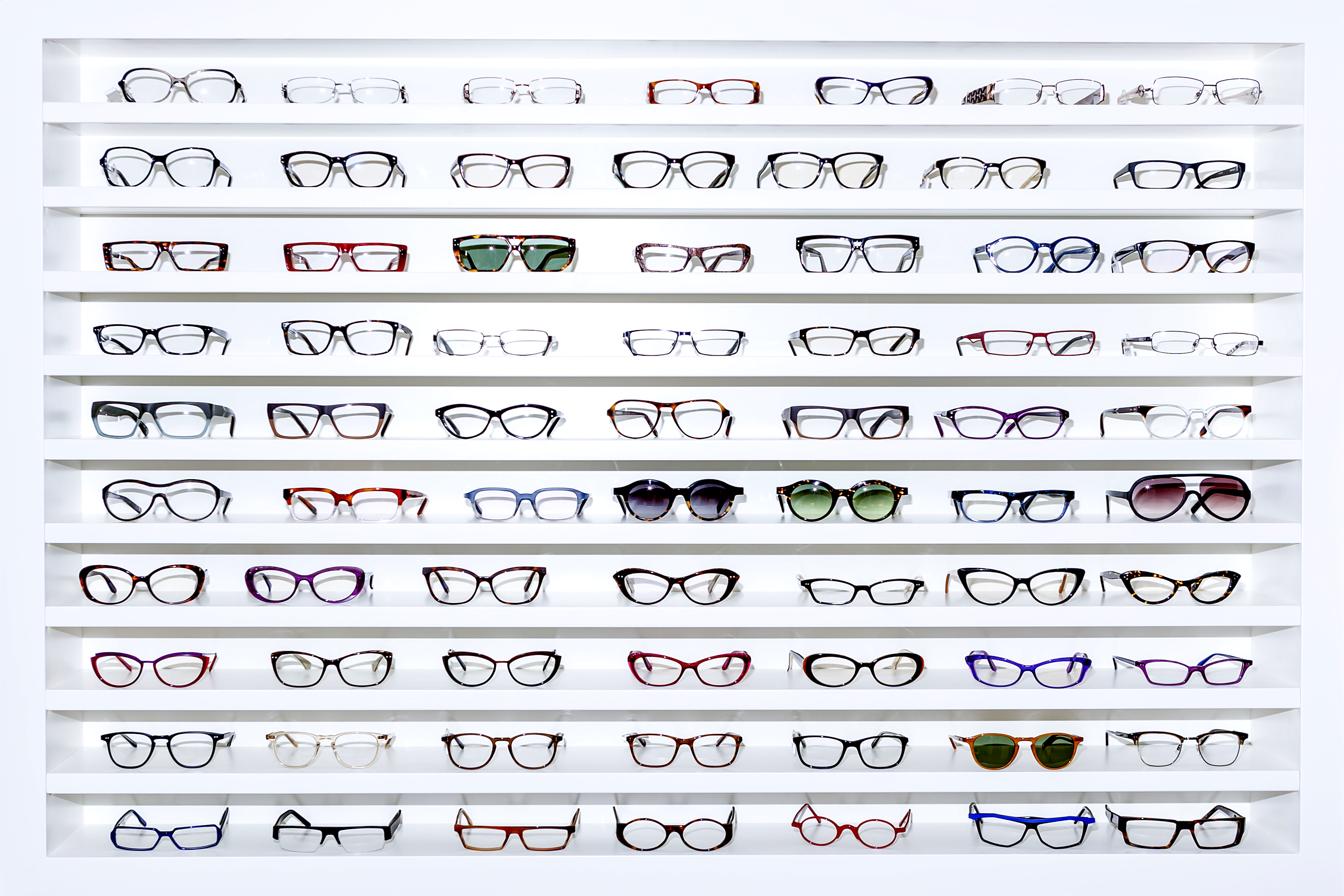The secretive mega-companies behind your glasses
If you have been wearing glasses for years, you may be surprised to discover that you see the world thanks to two giant companies that you have likely never heard of

Almost everyone wears glasses at some point in their lives. In developed countries, the rule of thumb is that around 70 percent of adults need corrective lenses to see well. And over the last generation, just two companies have risen above all the rest to dominate the industry. The lenses in my glasses — and yours too, most likely — were made by Essilor, a French multinational that controls almost half of the world's prescription lens business and has acquired more than 250 other companies in the past 20 years.
There is a good chance, meanwhile, that your frames were made by Luxottica, an Italian company with an unparalleled combination of factories, designer labels, and retail outlets. Luxottica pioneered the use of luxury brands in the optical business, and one of the many powerful functions of names such as Ray-Ban (which is owned by Luxottica) or Vogue (owned by Luxottica) or Prada (whose glasses are made by Luxottica) or Oliver Peoples (owned by Luxottica), or of outlets such as LensCrafters, the largest optical retailer in the U.S. (owned by Luxottica) or Sunglass Hut (owned by Luxottica), is to make the marketplace feel more varied than it actually is.
Between them, Essilor and Luxottica play a central, intimate role in the lives of a remarkable number of people. Around 1.4 billion of us rely on their products. Last year, the two companies had a combined customer base that is somewhere between Apple's and Facebook's, but with none of the hassle and scrutiny of being well known.
The Week
Escape your echo chamber. Get the facts behind the news, plus analysis from multiple perspectives.

Sign up for The Week's Free Newsletters
From our morning news briefing to a weekly Good News Newsletter, get the best of The Week delivered directly to your inbox.
From our morning news briefing to a weekly Good News Newsletter, get the best of The Week delivered directly to your inbox.
Now they are becoming one. On March 1, regulators in the EU and the U.S. gave permission for the world's largest optical companies to form a single corporation, which will be known as EssilorLuxottica. The new firm will not technically be a monopoly: Essilor currently has around 45 percent of the prescription lens market, and Luxottica 25 percent of the frames. But in seven centuries of spectacles, there has never been anything like it. The new entity will be worth around $50 billion, sell close to a billion pairs of lenses and frames every year, and have a workforce of more than 140,000 people.
No one is exactly sure what it is about early 21st-century urban living — the time we spend indoors, the screens, the color spectrum in LED lighting, or the needs of aging populations — but we are becoming a lens-wearing species. The need varies depending where you go, because different populations have different genetic predispositions to poor eyesight, but it is there, and growing. In Nigeria, around 90 million people, or half the population, are now thought to need corrective eyewear.
There are actually two things going on. The first is a largely unreported global epidemic of myopia, or nearsightedness, which has doubled among young people within a single generation. For a long time, scientists thought myopia was primarily determined by our genes. But about 10 years ago, it became clear that the way children were growing up was harming their eyesight, too. The effect is starkest in East Asia. In the 1950s, between 10 percent and 20 percent of Chinese people were nearsighted. Now, among teenagers and young adults, the proportion is more like 90 percent. In Seoul, 95 percent of 19-year-old men are myopic, many of them severely.
At the same time, across the developing world, a slower and more complex process is underway, as populations age and urbanize and move indoors to work. In 2018, an estimated 2.5 billion people, mostly in India, Africa, and China, are thought to need spectacles, but have no means to have their eyes tested or to buy them. Eye-health campaigners call it the largest untreated disability in the world. It is also a staggering business opportunity. Essilor and Luxottica know this.
A free daily email with the biggest news stories of the day – and the best features from TheWeek.com
Leonardo Del Vecchio is the patron, legend, and haunting spirit of the global eyewear business. His father died before he was born; his mother was poor; and he was raised in an orphanage in wartime Milan, where he went to work as a metal engraver at age 14. In 1961, Del Vecchio opened a workshop in the town of Agordo, in the Dolomite mountains. He was 25. The valley around Agordo was emptying out because of the closure of a mine, and the town was giving away land to companies that were willing to move there. Del Vecchio asked for 3,000 square meters on the riverbank to build a factory to make parts for spectacles.
Over the next half century, Del Vecchio grew his company, which was called Luxottica, into the world's greatest maker of glasses frames. He sought to control every element in the business, from the metal alloys of the hinges to the stores where eyewear is sold. In a series of audacious takeovers, Del Vecchio acquired brands such as Ray-Ban, Oakley, and Persol, and signed contracts with fashion houses such as Armani, Ralph Lauren, and Chanel. He built factories in China, and acquired vision insurance schemes in the U.S. and retail chains on four continents.
Since 1994, Del Vecchio has been Italy's highest individual taxpayer and the country's second-richest man. A few years ago, people thought his career had run its course. But in January 2017, at age 81, Del Vecchio announced the greatest deal of his life, in which he also secured the final missing part for his frames — the lenses — when Luxottica agreed to merge with Essilor. "He wants to do this merger," a former colleague said, "thinking he will leave behind this great company that will last for 100 years."
For the company's 30th anniversary, in 1991, Del Vecchio renovated some 15th-century stables in the middle of Agordo and opened a private glasses museum. The first glasses were almost certainly made in northern Italy in the last decades of the 13th century. But for centuries after their invention, spectacles and other magnifying lenses were mostly rejected by medical men, who recommended potions to correct people's eyesight instead. In The Perfect Oculist (1666), Robert Turner, a London doctor, recommended turtle's blood and the powdered head of a bat for the treatment of squints. For weak eyesight, you might try wearing cow's eyes around your neck.
The cabinets in Del Vecchio's museum traced the evolution from the leather frames and hinged bridges of the Middle Ages to the gold rims of the 19th century. No one knows why it took 400 years to put the arms on glasses — which are known as temples, and were pioneered in London in the early 18th century — so they finally sat comfortably on people's ears.
For its first 25 years, Luxottica stayed on the wholesale side of the industry, selling its glasses through optometrists to the public. In the 1990s, however, Del Vecchio decided he wanted a retail network too. First, he got Luxottica listed on the New York Stock Exchange, an almost unheard-of move for a midsize Italian business. The listing laid the groundwork for Del Vecchio's $1.4 billion hostile takeover of US Shoe, a conglomerate that owned LensCrafters, the country's largest optical chain, in 1995. On paper, the deal appeared outlandish. US Shoe was five times larger than Luxottica, and its board did not want to sell. Having its own shops would also put Luxottica in direct competition with the thousands of optometrists it had been supplying for decades.
But the deal got done. Del Vecchio promptly broke up US Shoe until all that was left were the LensCrafters stores, which he proceeded to fill with Luxottica frames. "That is exactly the formula they have used ever since," said Jeff Cole, the former CEO of Cole National Corp., an even larger optical retailer that sold out to Luxottica in 2004.
The formula means that when you or I walk into a LensCrafters, or a Sunglass Hut, or an Óticas Carol (which has 950 branches in Brazil), or a Xueliang Glasses in Shanghai, or a Ming Long store in Hong Kong, around 80 percent of the frames on display will be made by Luxottica.
In the factory in Agordo, I saw dual-armed robots pinning together the front and temples of Ray-Ban Wayfarers, and basket after basket of metal frames being dunked in a series of chemical baths to coat and color them. Glasses may appear to be relatively simple objects, but they involve between 180 and 230 manufacturing stages. Luxottica can take a pencil sketch to global production in about three weeks. "We are in a closed loop," said Giorgio Striano, Luxottica's chief operating officer. Taking into account all the different colors and face shapes (Japanese noses are not the same as Latino noses), Luxottica has around 27,000 models in production at any one time. Its plants turn out 400,000 pairs of frames per day. I asked Striano if any other company came close. "I think nobody," he said.
Del Vecchio's second great strategy is the one that changed the nature of the optical business — and that was to combine it with the fashion industry. In 1988, he signed a licensing deal with Giorgio Armani. Until then, consumers in Europe and America who wanted fancy spectacles had to rely on staid industry names such as Zeiss, Rodenstock, and Silhouette. After the Armani deal, they could buy Prada, Gucci, or Chanel, and they were willing to pay for it. "It created something," as one Luxottica manager artfully told me, "to make the needs where probably they are not."
Lenses are the pixie dust of the optical business. Barely anyone knows what they are made of, how they are constructed, or, especially at the high end, exactly how they work. The profit margins within the optical business are a closely guarded secret, but insiders explained to me that while optometrists might sell frames for 2 or 2.5 times their wholesale price, it is the lenses where they make the most money, charging markups of 700 or 800 percent. The largest margins of all are on complex progressive lenses and protective coatings — for scratch resistance, or to cut out blue light — features that cost Essilor a few cents to make, and which optometrists sell for between $25 and $50 a pop. Even Luxottica executives are awed by this. "Nobody knows how much lenses cost," one former marketing manager said. "The consumers don't know. Nobody knows."
Essilor holds more than 8,000 patents and funds university ophthalmology chairs around the world. In deals that rarely make the business pages, Essilor buys up Belgian optical laboratories, Chinese resin manufacturers, Israeli instrument makers, and British e-commerce websites. Within the industry, Essilor is regarded as a kind of unstoppable, enveloping tide.
The question now is whether there is anyone, beyond its shareholders, that will be able to hold EssilorLuxottica to account. I'm not sure there is.
"There is nothing close to that firepower once the combination is done," said Norbert Gorny, Essilor's head of R&D. And I thought about how one of the telling aspects of wearing glasses is that they help you notice everything else — and for the most part, see the world as it actually is — but it is only occasionally, through a chance reflection, or when you really take a moment to stop and look, that you see what is sitting on the top of your nose.
Excerpted from an article that originally appeared in The Guardian. Reprinted with permission.
-
 8 restaurants that are exactly what you need this winter
8 restaurants that are exactly what you need this winterThe Week Recommends Old standards and exciting newcomers alike
-
 ‘This is a structural weakening of elder protections’
‘This is a structural weakening of elder protections’Instant Opinion Opinion, comment and editorials of the day
-
 4 tips to safeguard your accounts against data breaches
4 tips to safeguard your accounts against data breachesThe Explainer Even once you have been victimized, there are steps you can take to minimize the damage